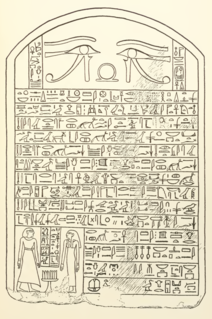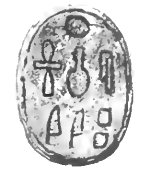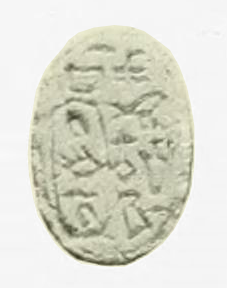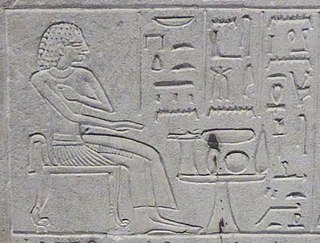
Sobekneferu reigned as Pharaoh of Egypt after the death of Amenemhat IV. She was the last ruler of the Twelfth Dynasty of Egypt and ruled Egypt for approximately four years from 1806 to 1802 BC. Her name means "the beauty of Sobek".

Amenemhat IV was the seventh and penultimate king of the Twelfth Dynasty of Egypt during the late Middle Kingdom period, ruling for more than nine years in the late nineteenth century BC or the early eighteenth century BC.

The Thirteenth Dynasty of ancient Egypt is often combined with Dynasties XI, XII and XIV under the group title Middle Kingdom. Some writers separate it from these dynasties and join it to Dynasties XIV through XVII as part of the Second Intermediate Period. Dynasty XIII lasted from approximately 1803 BC until approximately 1649 BC, i.e. for 154 years.

Khasekhemre Neferhotep I was an Egyptian pharaoh of the mid Thirteenth Dynasty ruling in the second half of the 18th century BC during a time referred to as the late Middle Kingdom or early Second Intermediate Period, depending on the scholar. One of the best attested rulers of the 13th Dynasty, Neferhotep I reigned for 11 years.

Khaneferre Sobekhotep IV was one of the more powerful Egyptian kings of the 13th Dynasty, who reigned at least eight years. His brothers, Neferhotep I and Sihathor, were his predecessors on the throne, the latter having only ruled as coregent for a few months.

Sekhemre Khutawy Sobekhotep was an Egyptian pharaoh of the 13th Dynasty during the Second Intermediate Period, who reigned for at least three years c. 1800 BC. His chronological position is much debated, Sekhemre Khutawy Sobekhotep being either the founder of the dynasty, in which case he is called Sobekhotep I, or its twentieth ruler, in which case he is called Sobekhotep II. In his 1997 study of the Second Intermediate Period, the Egyptologist Kim Ryholt makes a strong case for Sekhemre Khutawy Sobekhotep as the founder of the dynasty, a hypothesis that is now dominant in Egyptology. His tomb was believed to have been discovered in Abydos in 2013, but its attribution is now questioned.

Wahibre Ibiau was an ancient Egyptian pharaoh of the 13th Dynasty, who reigned c. 1670 BC for 10 years 8 months and 29 days according to the Turin King List.

Khaankhre Sobekhotep was a pharaoh of the Thirteenth Dynasty of Egypt during the Second Intermediate Period.

Seneferankhre Pepi III may have been a pharaoh of the 16th Dynasty during the Second Intermediate Period. According to Wolfgang Helck he was the fifth pharaoh of the dynasty. Alternatively, according to Jürgen von Beckerath, he was the thirteenth pharaoh of the dynasty. Because his position in the 16th Dynasty is highly uncertain, it is not clear who were his predecessor and successor.

Sobekhotep III was an Egyptian king of the Thirteenth Dynasty of Egypt who reigned three to four years, c. 1740 BC or 1700 BC.

Nubkhaes was an ancient Egyptian queen with the titles Great Royal Wife and the one united with the beauty of the white crown. She is so far only known from her family stela now in the Louvre and a few later references. The stela is the main monument of the queen. Here is mentioned her father Dedusobek Bebi and other family members, many of them high court officials. These are all datable to about the time of king Sobekhotep IV.

Neferkare Iymeru was the ancient Egyptian vizier under king Sobekhotep IV in the 13th Dynasty, around 1750 BC.

Ineni was an ancient Egyptian queen who lived during the Thirteenth Dynasty .
She is so far only known from 21 scarabs and a seal impression from Kerma. She had the titles Great Royal Wife and she, who is united with the white crown. She is one of the first ancient Egyptian queens whose name was written within a cartouche. This approach to writing a name was previously only used for kings' names and some kings' daughters holding special positions. The name of Ineni's husband is not known with any certainty. It is thought that it was king Merneferre Ay, as her scarabs are similar in style to that of this king.

Senebi was an ancient Egyptian treasurer under the 13th Dynasty kings Neferhotep I and Sobekhotep IV. Senebi belongs to the best attested officials of the 13th Dynasty.

Senebhenaf was an ancient Egyptian vizier during the Second Intermediate Period.

Khahotepre Sobekhotep VI was an Egyptian king of the 13th Dynasty during the Second Intermediate Period. According to Egyptologist Kim Ryholt he was the thirty-first pharaoh of the dynasty, while Darrell Baker believes instead that he was its thirtieth ruler. Alternatively, Jürgen von Beckerath and Detlef Franke see him as the twenty-fifth king of the dynasty.
Merkawre Sobekhotep was the thirty-seventh pharaoh of the Thirteenth Dynasty of Egypt during the Second Intermediate Period. He probably reigned over Middle and perhaps Upper Egypt during the mid-17th century BC from 1664 BC until 1663 BC. Alternatively, the German Egyptologist Thomas Schneider dates this short-lived king's reign from 1646 BC to 1644 BC

Menwadjre Sihathor was an ephemeral ruler of the 13th Dynasty during the late Middle Kingdom. Sihathor may never have enjoyed an independent reign, possibly only ruling for a few months as a coregent with his brother Neferhotep I. According to Egyptologist Kim Ryholt, Sihathor died in 1733 BC while Detlef Franke dates his short reign to 1694 BC. His tomb is likely to be the unfinished one located between the tombs of his brothers S9 and S10, in Abydos.

Haankhef was the father of the ancient Egyptian kings Neferhotep I, Sihathor, and Sobekhotep IV, who successively ruled Egypt during the second half of the 18th century BC as kings of the 13th Dynasty.
Neni was an ancient Egyptian queen of the Thirteenth Dynasty. She was the wife of king Sobekhotep III and the mother of two of his daughters: Iuhetibu Fendy and Dedetanqet. The only title attested for Neni is king's wife, the regular title of queens of this period. Not much else is known about her. There is a stela set up by her steward attesting that Neni had her own estates.















